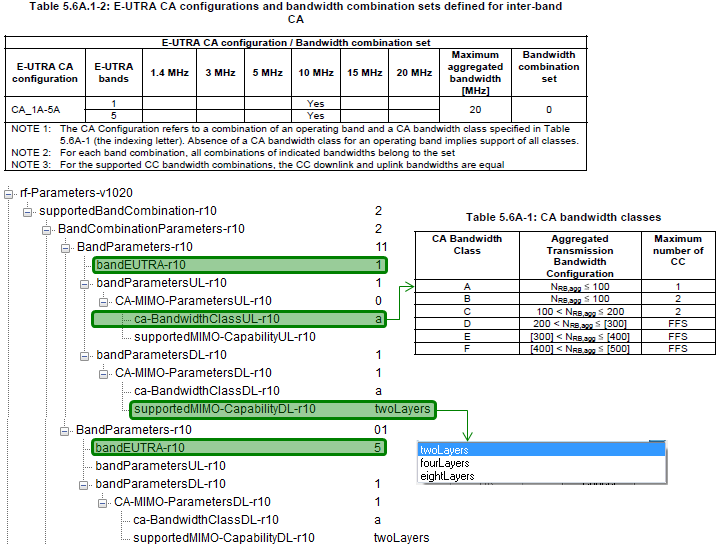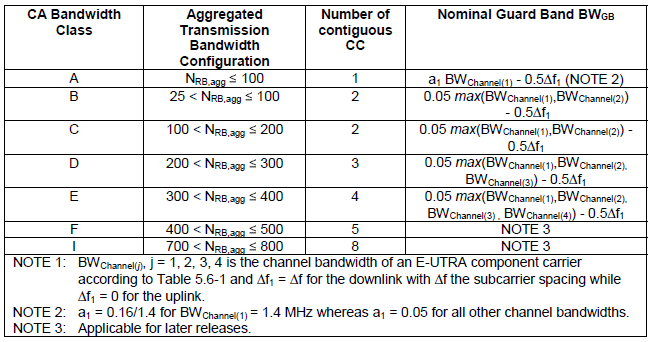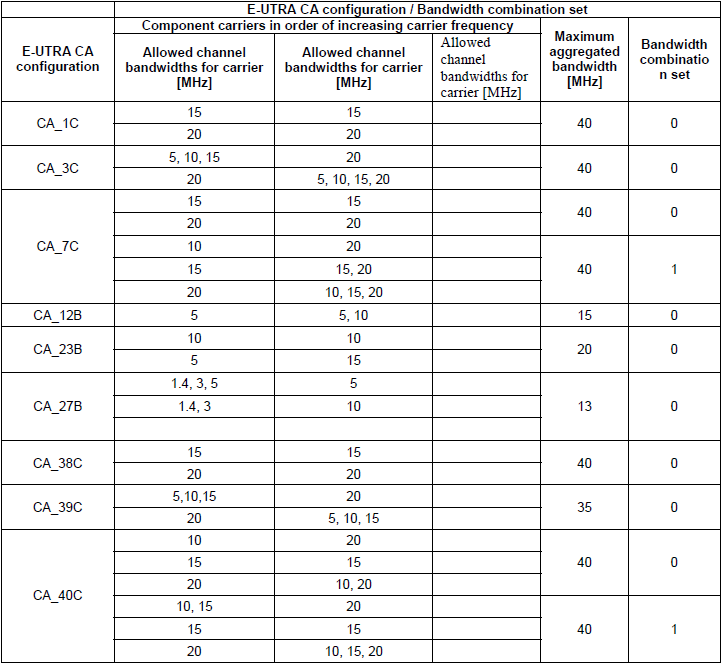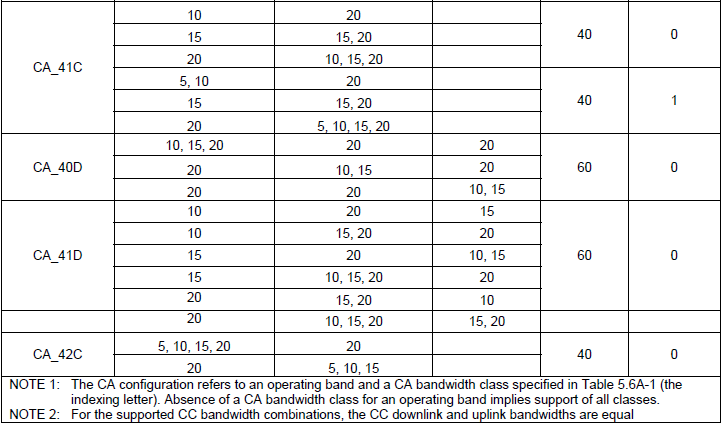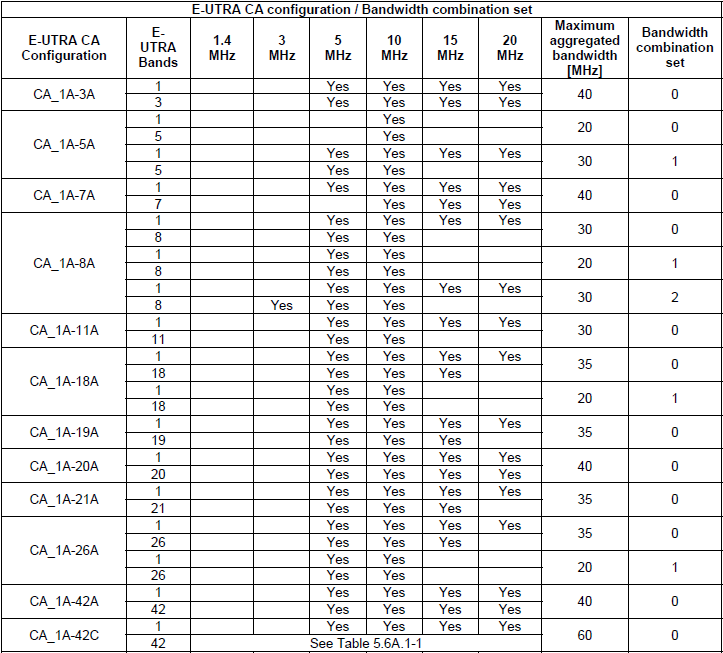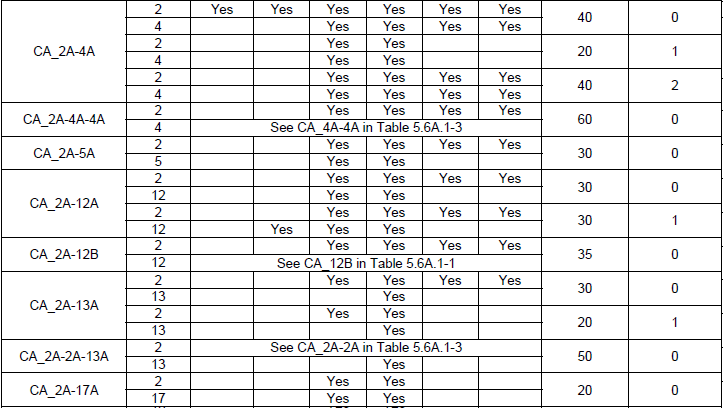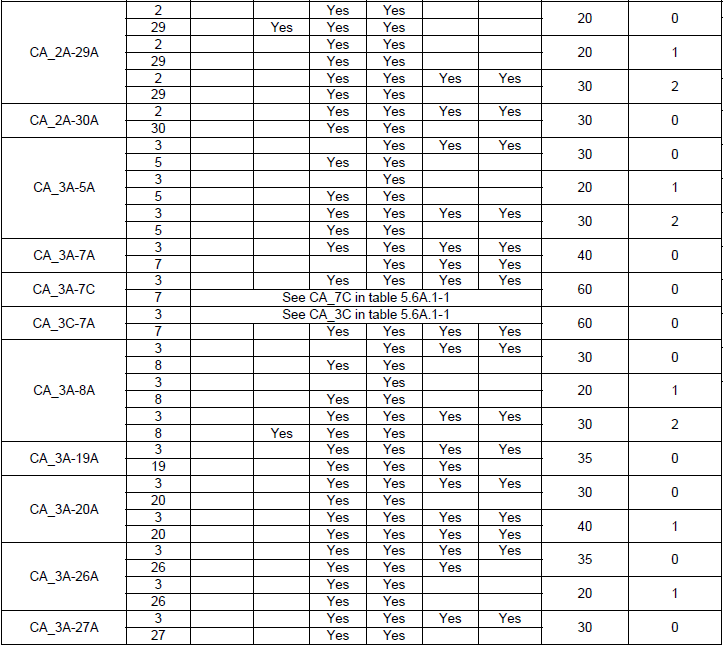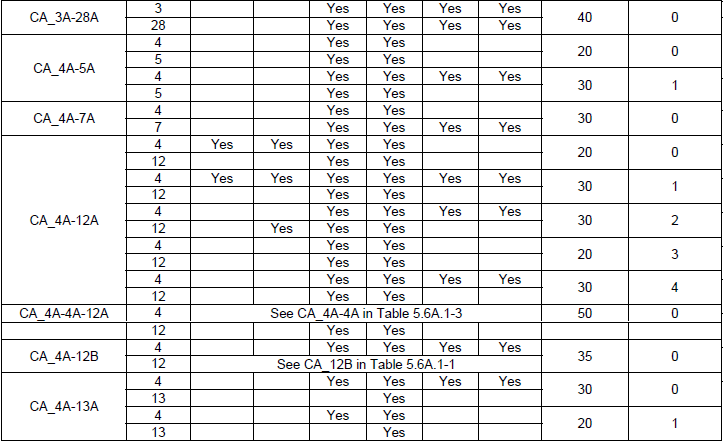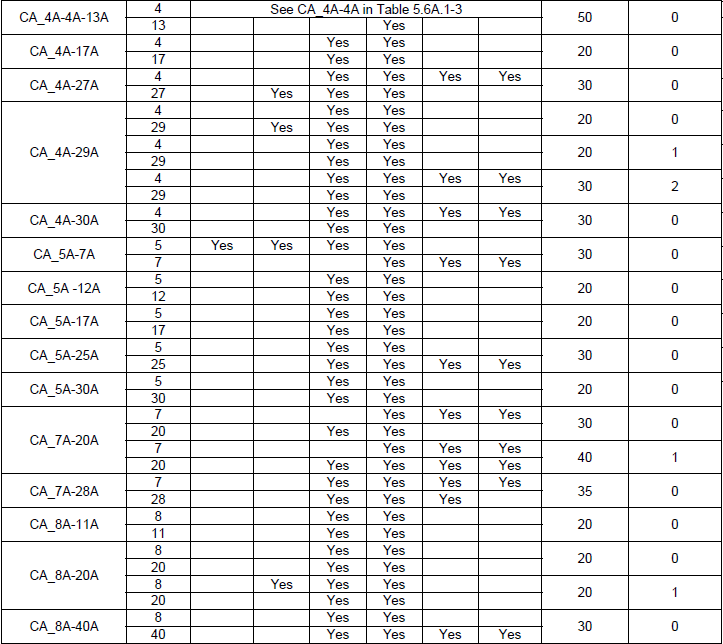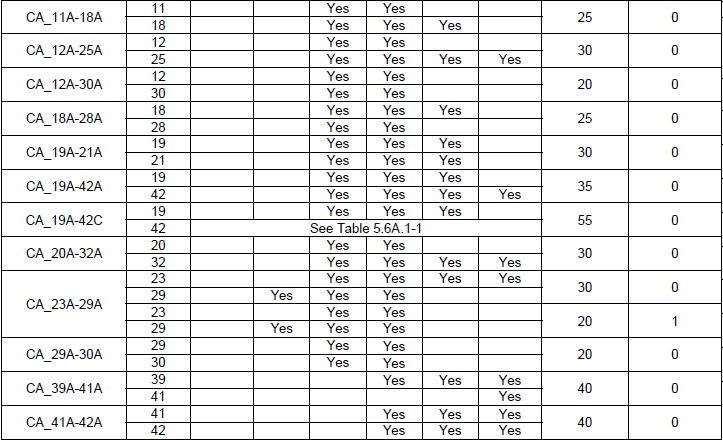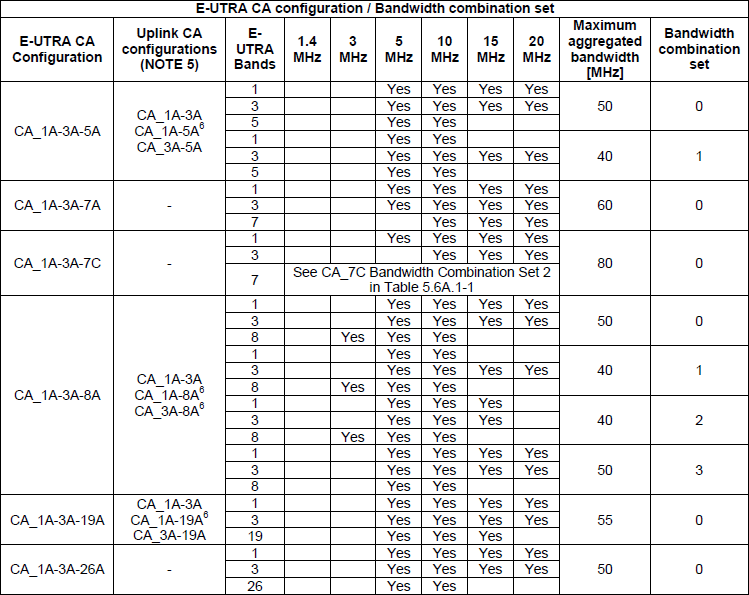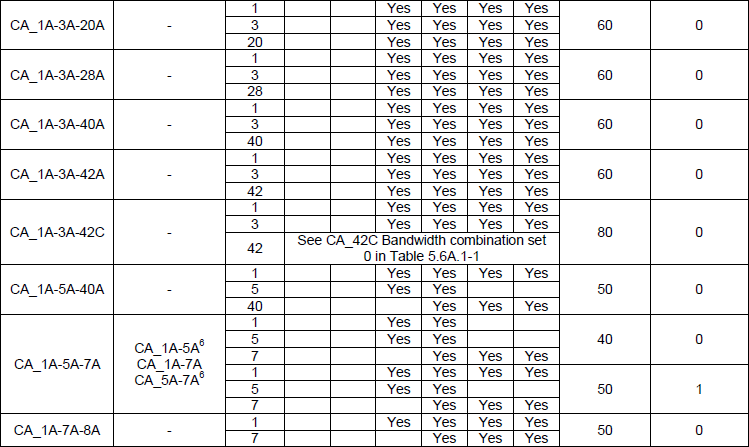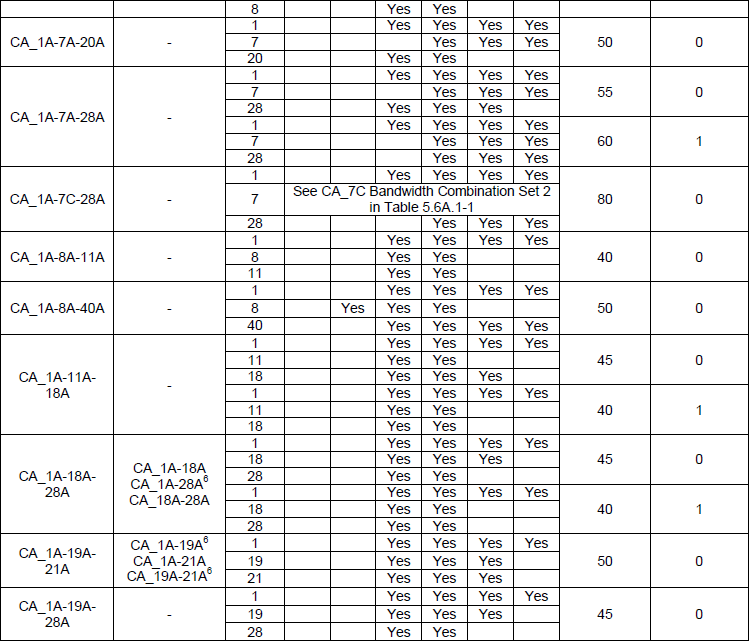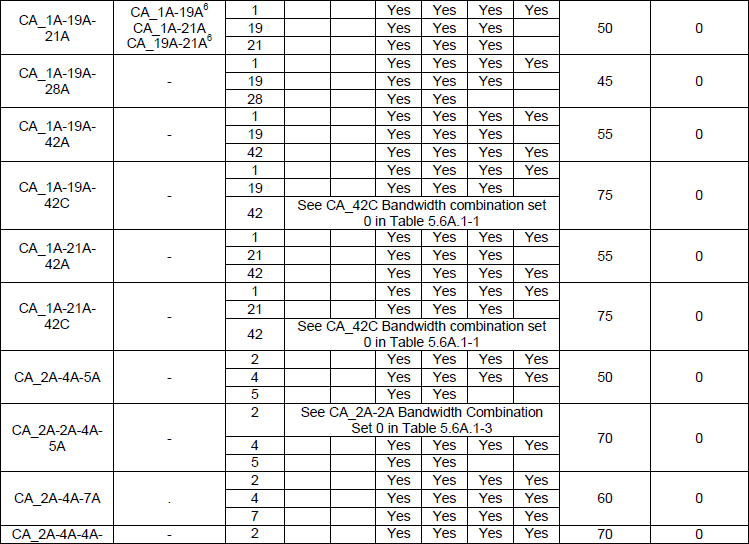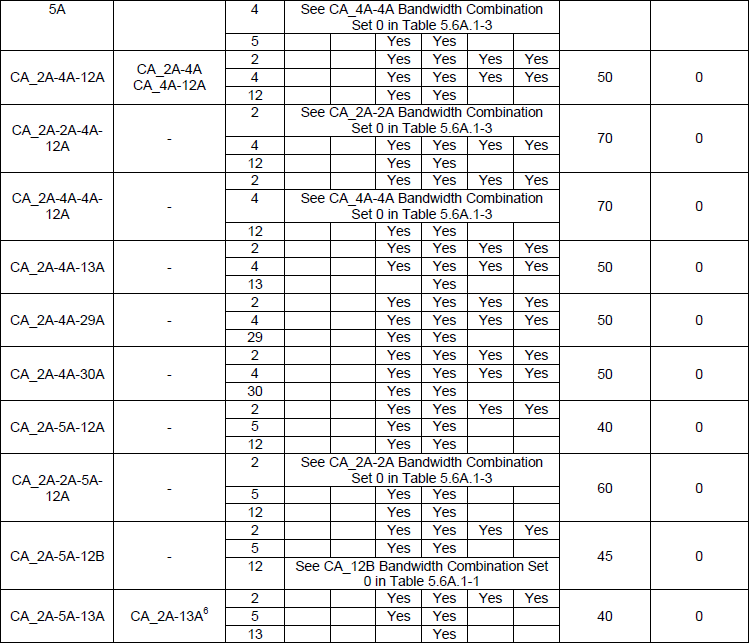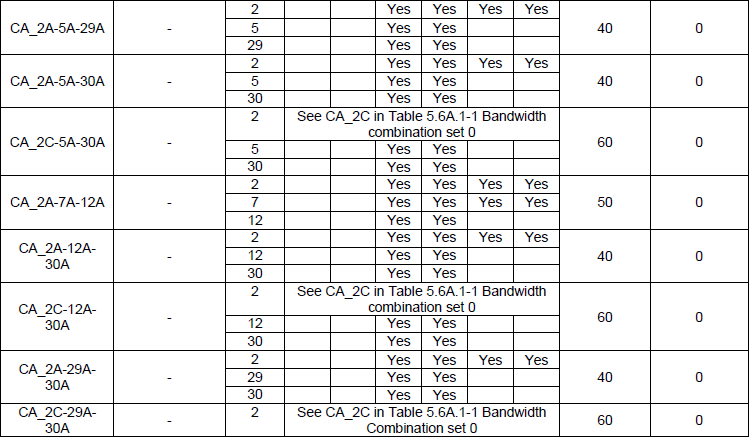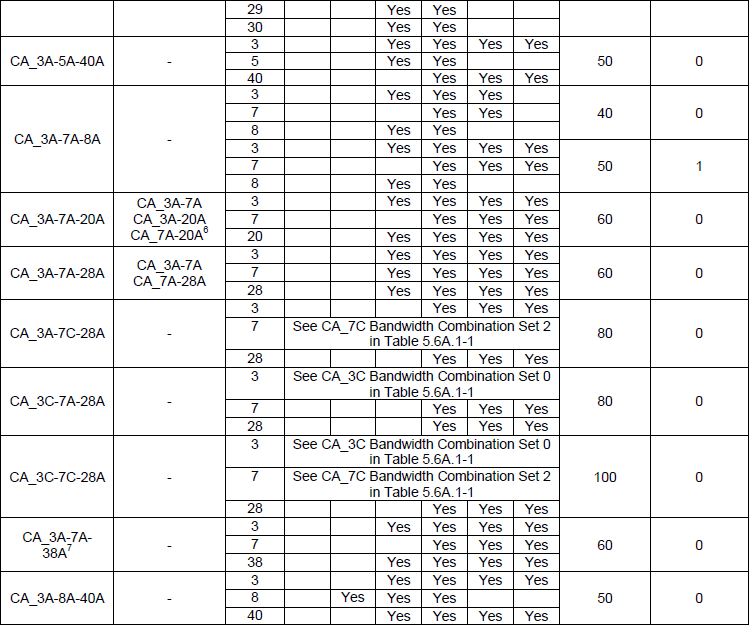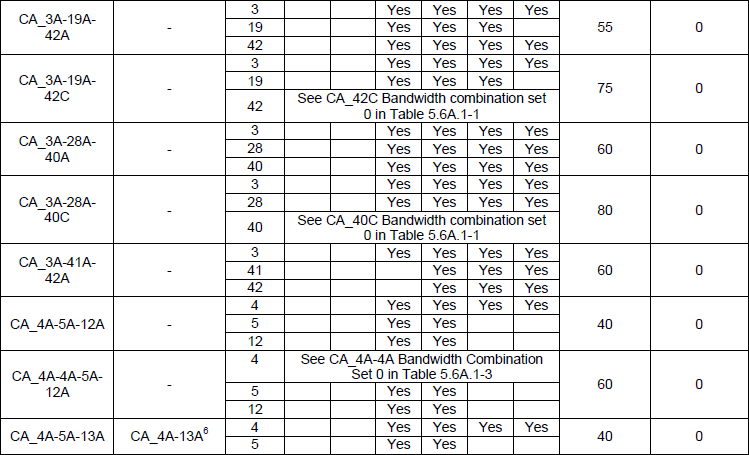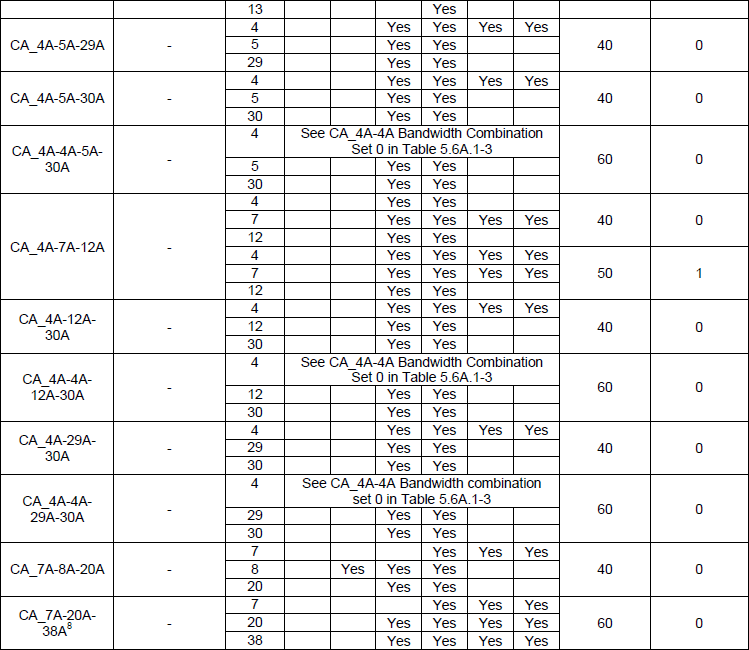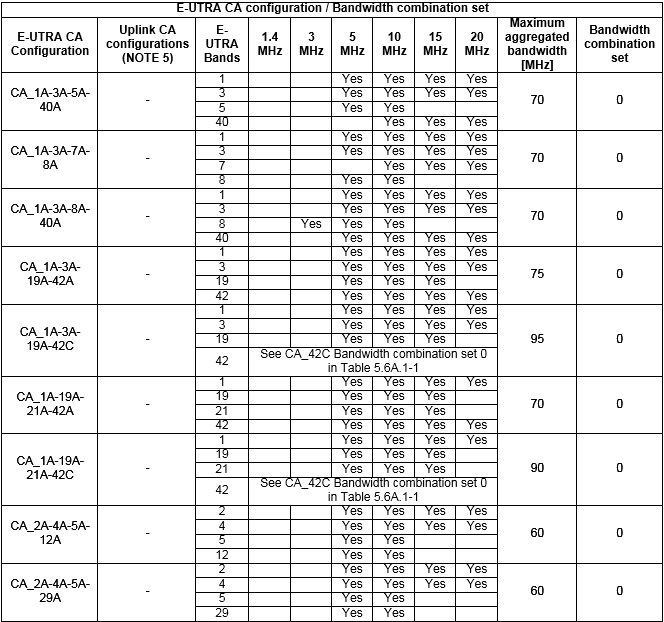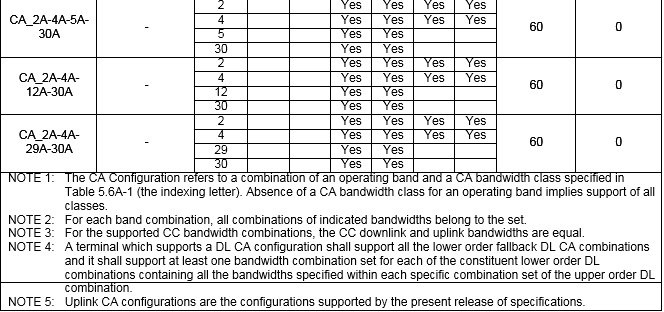|
4G/LTE - LTE Advanced |
||
|
Band Combination Definition
The most important thing you have to pay attention in UE Capability Information is CA Band combination as specified in RRC message as shown below.
Following is the example for Band combination of a 3CC Carrier Aggregation. nonCriticalExtension ue-Category-v1020: 6 rf-Parameters-v1020 supportedBandCombination-r10: 15 items Item 0 BandCombinationParameters-r10: 3 items Item 0 BandParameters-r10 bandEUTRA-r10: 1 bandParametersUL-r10: 1 item Item 0 CA-MIMO-ParametersUL-r10 ca-BandwidthClassUL-r10: a (0) bandParametersDL-r10: 1 item Item 0 CA-MIMO-ParametersDL-r10 ca-BandwidthClassDL-r10: a (0) supportedMIMO-CapabilityDL-r10: twoLayers (0) Item 1 BandParameters-r10 bandEUTRA-r10: 5 bandParametersDL-r10: 1 item Item 0 CA-MIMO-ParametersDL-r10 ca-BandwidthClassDL-r10: a (0) supportedMIMO-CapabilityDL-r10: twoLayers (0) Item 2 BandParameters-r10 bandEUTRA-r10: 7 bandParametersDL-r10: 1 item Item 0 CA-MIMO-ParametersDL-r10 ca-BandwidthClassDL-r10: a (0) supportedMIMO-CapabilityDL-r10: twoLayers (0)
Another important part is featureGroupIndicator (FGI) for r10. It has following items.
featureGroupIndRel10-r10: 00000000 [bit length 32, 0000 0000 0000 0000 0000 0000 0000 0000 decimal value 0] 0... .... = Indicator 101: DMRS with OCC (orthogonal cover code) and SGH (sequence group hopping) disabling - Not supported .0.. .... = Indicator 102: Trigger type 1 SRS (aperiodic SRS) transmission (Up to X ports) - Not supported ..0. .... = Indicator 103: PDSCH TM9 when up to 4 CSI reference signal ports are configured - Not supported ...0 .... = Indicator 104: PDSCH TM9 for TDD when 8 CSI reference signal ports are configured - Not supported .... 0... = Indicator 105: PUCCH RM2-0 when PDSCH TM9 is configured and RM2-1 when PDSCH TM9 and up to 4 CSI reference signal ports are configured - Not supported .... .0.. = Indicator 106: PUCCH RM2-1 when PDSCH TM9 and 8 CSI reference signal ports are configured - Not supported .... ..0. = Indicator 107: PUSCH RM2-0 when PDSCH TM9 is configured and RM2-2 when PDSCH TM9 and up to 4 CSI reference signal ports are configured - Not supported .... ...0 = Indicator 108: PUSCH RM2-2 when PDSCH TM9 and 8 CSI reference signal ports are configured - Not supported 0... .... = Indicator 109: PUCCH RM1-1 submode 1 - Not supported .0.. .... = Indicator 110: PUCCH RM1-1 submode 2 - Not supported ..0. .... = Indicator 111: Measurement reporting trigger Event A6 - Not supported ...0 .... = Indicator 112: SCell addition within the Handover to EUTRA procedure - Not supported .... 0... = Indicator 113: Trigger type 0 SRS (periodic SRS) transmission on X Serving Cells - Not supported .... .0.. = Indicator 114: Reporting of both UTRA CPICH RSCP and Ec/N0 in a Measurement Report - Not supported .... ..0. = Indicator 115: Time domain ICIC RLM/RRM / ICIC RRM / ICIC CSI measurement sf restriction for the serving cell / neighbour cells - Not supported .... ...0 = Indicator 116: Relative transmit phase continuity for spatial multiplexing in UL - Not supported
CA Bandwidth Class Definition
Following table shows Carrier Aggregation Bandwidth Class in terms of total number of RBs used by aggregated carrier.
For example, CA Bandwidth Class 'B' says N_RB,agg <= 100. It means that total aggregated RB should be less than 100. Following shows some example cases which is allowed and not allowed configuration. Case 1 : PCC = 10 Mhz (max 50 RB), SCC = 10 Mhz (max 50 RB). It would give max aggregated RB is 50 RB +50 RB which is <= 100. So this is allowed.
Case 2 : PCC = 10 Mhz (max 50 RB), SCC = 15 Mhz (max 75 RB). It would give max aggregated RB is 50 RB +75 RB which is >= 100. So this is not allowed. 36.101(Rel 13) - Table 5.6A-1: CA bandwidth classes and corresponding nominal guard bands
This bandwidth class supported by a UE is reported to network via UE Capability Information message as shown below.
Following is the example for 2CC Carrier Aggregation supportability : DL 4A_17A, UL 4A nonCriticalExtension rf-Parameters-v1020 supportedBandCombination-r10: 1 item Item 0 BandCombinationParameters-r10: 2 items Item 0 BandParameters-r10 bandEUTRA-r10: 4 bandParametersUL-r10: 1 item Item 0 CA-MIMO-ParametersUL-r10 ca-BandwidthClassUL-r10: a bandParametersDL-r10: 1 item Item 0 CA-MIMO-ParametersDL-r10 ca-BandwidthClassDL-r10: a supportedMIMO-CapabilityDL-r10: twoLayers Item 1 BandParameters-r10 bandEUTRA-r10: 17 bandParametersDL-r10: 1 item Item 0 CA-MIMO-ParametersDL-r10 ca-BandwidthClassDL-r10: a supportedMIMO-CapabilityDL-r10: twoLayers
Following is the example for Band class of a 3CC Carrier Aggregation : DL 1A_5A_7A, UL 1A nonCriticalExtension ue-Category-v1020: 6 rf-Parameters-v1020 supportedBandCombination-r10: 15 items Item 0 BandCombinationParameters-r10: 3 items Item 0 BandParameters-r10 bandEUTRA-r10: 1 bandParametersUL-r10: 1 item Item 0 CA-MIMO-ParametersUL-r10 ca-BandwidthClassUL-r10: a (0) bandParametersDL-r10: 1 item Item 0 CA-MIMO-ParametersDL-r10 ca-BandwidthClassDL-r10: a (0) supportedMIMO-CapabilityDL-r10: twoLayers (0) Item 1 BandParameters-r10 bandEUTRA-r10: 5 bandParametersDL-r10: 1 item Item 0 CA-MIMO-ParametersDL-r10 ca-BandwidthClassDL-r10: a (0) supportedMIMO-CapabilityDL-r10: twoLayers (0) Item 2 BandParameters-r10 bandEUTRA-r10: 7 bandParametersDL-r10: 1 item Item 0 CA-MIMO-ParametersDL-r10 ca-BandwidthClassDL-r10: a (0) supportedMIMO-CapabilityDL-r10: twoLayers (0)
Followings are some more examples without the detailed RRC message.
How to figure out BandCombination and Bandwidth Class supported by a UE ?
Now the question you may ask is how can I know which band combination of bands a UE support in terms of Carrier Aggregation ? It is also supposed to be reported to network by the UE via UE Capability Information message. Followings are some of the possible IEs a UE may use depending on its release status. RF-Parameters-v1020 ::= SEQUENCE { supportedBandCombination-r10 SupportedBandCombination-r10 }
RF-Parameters-v1090 ::= SEQUENCE { supportedBandCombination-v1090 SupportedBandCombination-v1090 OPTIONAL }
RF-Parameters-v1130 ::= SEQUENCE { supportedBandCombination-v1130 SupportedBandCombination-v1130 OPTIONAL }
The definition of these IE is described as below in 36.331. Generally it sounds OK.. but it is not very clear to me if I go into one step deeper. For example, this definition does not clearly explain on which item in the list can be a PCC (Primary Component Carrier) and which should be SCC (Secondary Component Carrier). As far as I know, there is no priority of these items in terms of determining PCC/SCC, meaning either one should be allowed to be PCC depending on situation. But you may see some UE that allows only specific PCC/SCC mapping. bandCombinationListEUTRA : One entry corresponding to each supported band combination listed in the same order as in supportedBandCombination.
BandCombinationParameters-v1090 : If included, the UE shall include the same number of entries, and listed in the same order, as in BandCombinationParameters-r10.
BandCombinationParameters-v1130 :The field is applicable to each supported CA bandwidth class combination (i.e. CA configuration in TS 36.101 Section 5.6A.1 indicated in the corresponding band combination
One example of Carrier Combination information in UE Capability Information is as follows. This example shows the UE allows Carrier Aggregation between band 4 and band 17.
nonCriticalExtension rf-Parameters-v1020 supportedBandCombination-r10: 1 item Item 0 BandCombinationParameters-r10: 2 items Item 0 BandParameters-r10 bandEUTRA-r10: 4 bandParametersUL-r10: 1 item Item 0 CA-MIMO-ParametersUL-r10 ca-BandwidthClassUL-r10: a bandParametersDL-r10: 1 item Item 0 CA-MIMO-ParametersDL-r10 ca-BandwidthClassDL-r10: a supportedMIMO-CapabilityDL-r10: twoLayers Item 1 BandParameters-r10 bandEUTRA-r10: 17 bandParametersDL-r10: 1 item Item 0 CA-MIMO-ParametersDL-r10 ca-BandwidthClassDL-r10: a supportedMIMO-CapabilityDL-r10: twoLayers
BandCombination and BandwidthClass defined by 3GPP
Following Table from 36.101 V12.5.0 (2014-11) shows all the possible (allowed) band combination of inter-band CA case. This list is likely to get extended as time goes on. So try to refer to latest spec.
When you want to analyze UE capability, you can refer to bandEUTRA-r10 and ca-BandwidthClassDL-r10 in a BandCombinationParameters to figure out complete CA configuration as expressed in the first column of following tables.
< 36.101 Table 5.6A.1-1: E-UTRA CA configurations and bandwidth combination sets defined for intra-band contiguous CA >
< 36.101 Table 5.6A.1-2: E-UTRA CA configurations and bandwidth combination sets defined for inter-band CA >
< 36.101-V13.3.0 Table 5.6A.1-2a: E-UTRA CA configurations and bandwidth combination sets defined for inter-band CA (three bands) >
Following table is the 4 CC combination defined in 36.101 v13.2.1 Table 5.6A.1-2b: E-UTRA CA configurations and bandwidth combination sets defined for inter-band CA (four bands)
< 36.101 v13.2.1 Table 5.6A.1-2b: E-UTRA CA configurations and bandwidth combination sets defined for inter-band CA (four bands) >
One of the UE capability information that may confuses you would be following IE. This IE shows you which band are supported by the UE in terms of single carrier. It is not about Carrier Aggregation.
rf-Parameters supportedBandListEUTRA: 4 items Item 0 SupportedBandEUTRA bandEUTRA: 2 ..0. .... halfDuplex: False Item 1 SupportedBandEUTRA bandEUTRA: 4 .0.. .... halfDuplex: False Item 2 SupportedBandEUTRA bandEUTRA: 5 0... .... halfDuplex: False Item 3 SupportedBandEUTRA bandEUTRA: 17 .... ...0 halfDuplex: False
|
||
